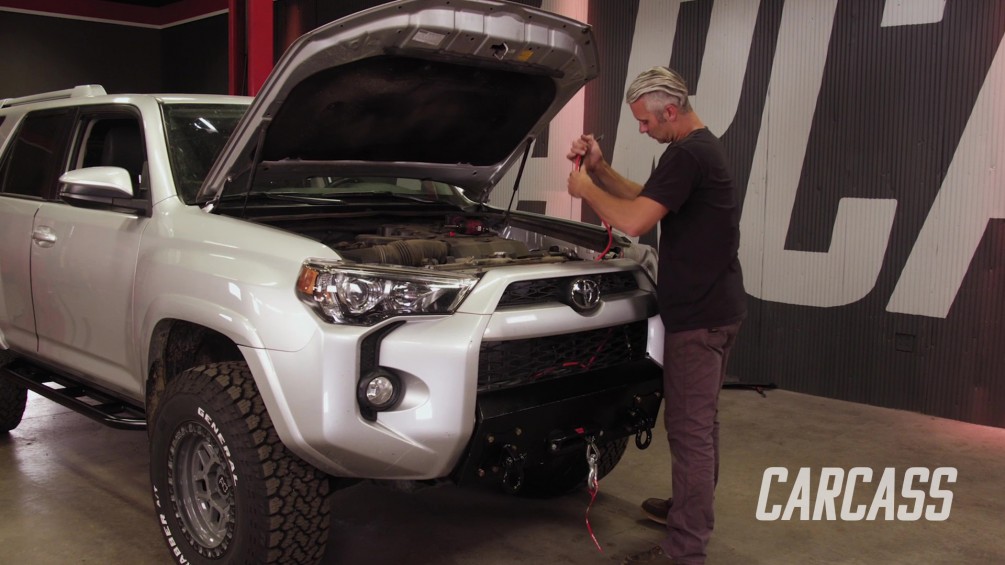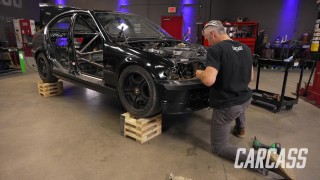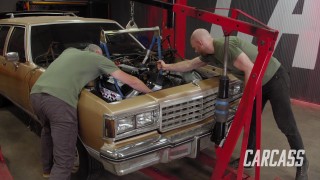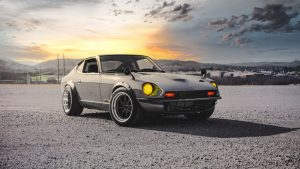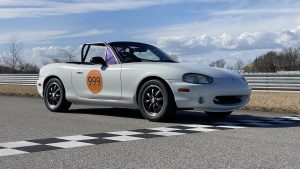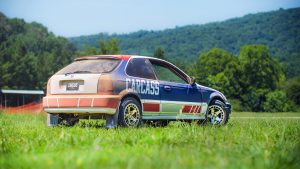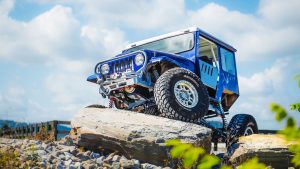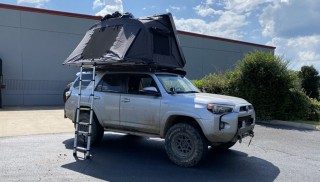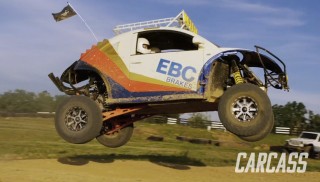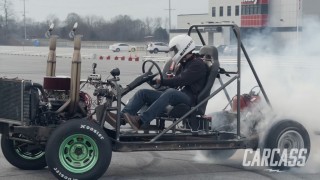More 4Runner Funner Overlander Episodes
Carcass Featured Projects
Carcass Builds
Want more content like this?
Join the PowerNation Email NewsletterParts Used In This Episode
iKamper
Skycamp 3.0
Lightforce Performance Lighting
ROK 40 Lights
Lightforce Performance Lighting
Striker LED Driving Lights
The Industrial Depot
Tools, Hardware, Shop Supplies
Episode Transcript
(Jimmy)>> You're watching Powernation!
(Jimmy)>> Hey everyone, Jeremy and I are finishing up a few things for our Toyota 4Runner build. Things like the front bumper, rear bumper, and our rock sliders. Although I do love the look of raw steel, we are gonna be finishing these things out with some black paint just to complete the look, and also to continue with the overlanding theme we are gonna be adding more stuff to the exterior of our s-u-v. And that all happens today on Carcass. [ Music ] [ engine revving ] [ Music ]
(Jeremy)>> Alright sweet man! You ready to get started?
(Jimmy)>> Let's do it.
(Jeremy)>> Hey guys, welcome to the show. Well, we're in the paint booth today. We are not inside. We are getting ready to spray paint all of the stuff that we built for the Toyota 4Runner overlanding project. Now before we can lay down any color, we've got to hang all this stuff up and give it a good wipe down. Got some pieces of wire to help hang up with?
(Jimmy)>> Yep! [ Music ]
(Jeremy)>> The easiest way we found to hang up all of our parts was to use a couple of tall jack stands and some pieces of pipe across the top. To hang up the parts we're using mechanics wire, or if you don't have that you can use regular old welding wire. [ Music ] This thing's heavy! [ Music ] Good, goodish?
(Jimmy)>> I'm good! [ Music ]
(Jeremy)>> Some of these parts can be a two person job. Just make sure you put enough wire on, or that you have heavy enough wire to support the weight of your pieces. [ Music ] Now that we have everything hung up, we'll go ahead, wipe it down with some wax and grease remover. [ Music ] There are many different steps you need to take before you can put paint on your project. Take your time because you want the material you're spraying to last a lifetime. [ Music ] This is probably one of the most important steps you can do before you paint is get all of the junk off of it. Like this is all from the milling process, or the processes of when they make the steel, and they coat it so when it shows up at your door it's not full of rust. So, we've got to get all that stuff off of there and get this stuff ready to paint. Alright, so this is a really important step. What we're gonna be doing is spraying this bare steel with some self-etching primer. What this does is it's gonna help the paint stick on this stuff and make sure it doesn't fall off when we're out running this thing through the trails. [ Music ] This primer is the second step in our painting process to make sure that our parts and pieces come out perfectly. [ Music ] With this we'll lay down a couple of light coats to make sure we have complete coverage. [ Music ] [ aerosol can hissing ]
(Jimmy)>> While Jeremy's laying down primer on our parts I'm gonna be mixing up some paint. We're going with Summit Racing's hot rod flat single stage in black, which is a no brainer for us because our 4Runner is silver and all the other pieces on that s-u-v are some shade of gray or black. Summit Racing is awesome because they have everything that you need to complete your next paint project. Everything from paint, activators or reducers, wax and grease removers, thinners. They also have paint guns and accessories, and all the mixing supplies that you need to complete your project. I'm gonna mix this stuff four to one, and we'll get Jeremy spraying. When you mix up your paint you want to shoot for a nice, clean pour and keep your workspace perfectly clean. [ Music ]
[ electrical fan humming ]
(Jeremy)>> I'm probably gonna need a little bit more than this. You want to mix some more up?
(Jimmy)>> Okay! [ Music ]
(Jeremy)>> We're spraying all of our pieces in our Mobile Environmental Solutions paint booth. You've seen us use these paint booths before to do complete paint jobs on different projects, but they also work great for painting small parts, installing spray on bed liners, staining and painting cabinets, and even doing paintless dent removal. These paint booths are a positive pressure design. They use the air that keeps the booth erect as a cross flow system to move the inside air from the front of the booth to the back. This creates a paint booth that you can use anywhere. They come in many different sizes. We're using their 23 by 15, which is ideal for painting our small pieces. [ spray gun hissing ] [ Music ]
(Jimmy)>> We add some trail support to our new bumper with a heavy duty winch and some recovery accessories. Then add a new battery that is built for the trails.
(Jeremy)>> Well we're all wrapped up inside the MES paint booth. Our paint has had time to flash, and we've started assembly. We've got the rock sliders already welded to the chassis, and that turned out really well. Now I've got the bumper and the spare tire carrier going on the back here. I just have to button this up, but that's just the rear, and the work in the front is just getting started.
(Jimmy)>> I'm getting ready to put the front bumper along with the winch on the front of our 4Runner, and as far as the winch goes it was a pretty easy choice going with the Warn VR Evo-10-S and it has one feature in particular that we wanted and that is Bluetooth capability so we can activate this thing just with a remote. We don't have to worry about wires coming out everywhere. And also, as far as engaging it all we have to do is pop the hood, reach our hand in between the core support and the grille, and then just flip the lever. The only tricky part about this is we have to install the winch in the bumper before we actually throw it on the front. So, it will get pretty heavy here. [ Music ] I'll install the winch with all the hardware included in the kit and get this thing on the truck. [ Music ]
Alright Jeremy, you want to help me get this.
(Jeremy)>> Yeah, it's a little heavier than last time, right?
(Jimmy)>> Yeah! [ Music ]
We'll tighten the bolts down to hold on the bumper, and then put on the cover plates with our D-rings. [ impact drill vibrating ] [ Music ]
Last to go on will be the stock grille, which integrates back in nicely with our bumper just by using a couple of screws. [ Music ]
(Jeremy)>> Got that winch installed.
(Jimmy)>> Yep, everything's in there. Just got to run the cables.
(Jeremy)>> I've got a battery upgrade. So, we can definitely support having that winch in here. [ drill humming ] [ Music ]
(Jeremy)>> Let's get this one out of here and put the new one in. [ Music ] Now to power up our 4Runner we're running an Optima Red Top battery. Now this is an a-g-m battery. That stands for absorbent glass mat. Basically, means it's 15 times more resistant to vibration, which will be great for our 4Runner when we're running this thing off the beaten path. Plus, it's got dual posts, which means it's a top post and a side post. So, it will give us connection points for our winch. Now this thing will definitely power up all of our accessories, plus give us a little more juice to run a couple more things we've got planned a little bit later on. [ Music ] After we make our battery connections on the top post, we'll connect our winch cables on the side post. [ Music ] [ winch buzzing ]
(Jimmy)>> It works!
(Jeremy)>> I just did a quick test here.
(Jimmy)>> Going old school with the plug in remote.
(Jeremy)>> I figured we might as well just plug it in and see if it all works.
(Jimmy)>> We can plug in our wireless transmitter and go all Bluetooth on it and it'll work out nice.
(Jeremy)>> I think we're pretty much buttoned up underneath there. We'll just kinda keep moving on.
(Jimmy)>> Kinda see what we need to do to get the roof rack on it and get the tent up there.
(Jeremy)>> Sounds good! Coming up, we remove the factory roof rack and replace it with a longer and stronger one to give us more cargo space and help us support our new rooftop tent.
(Jeremy)>> With the bumpers, the sliders, the winch, and the battery installed we're gonna keep checking some things off the list, and that brings us up top to the 4Runner. Now the roof rack that's up here only covers about two-thirds of the roof, and we're missing the cross bars anyways. So, this doesn't do us any good. The idea here is to do a bit of an upgrade. We're gonna end up running a roof rack that runs the full length of the roof, and we're gonna be setting something on top of that a little bit later. But first things first, let's get rid of this one. Using a plastic trim removal tool, I'll pop off the covers and remove the bolts that hold on the side rails. [ Music ] Now you guys can see that our new roof rack is quite a bit longer than the original one on the 4Runner. This is an M-series roof rack. It's built by K/C. We picked this one up from Summit Racing, and we do have to assemble this one. The instructions say to do it right here on the ground. I'll do it upside down and then we'll flip it over and get it up on the 4Runner. We'll start by attaching the brackets that secure the side rails, which also doubles as a roof mount. [ drill buzzing ]
(Jeremy)>> Next here we'll put these side pieces on. I have to start every one on this side, and then we'll go do the other side too. [ Music ] Our support rails are attached with stainless steel allen bolts that are supplied in the kit. [ Music ] Stretch over the mirrors and can set them right on those little stands here. Just like that! One thing I already did was pull off this little piece of weatherstripping. It kinda goes in the channel where they seamed the body together. So, what I have to do now is put a couple of these little bolts in, and then we have to mark out the holes that we have to drill so we can put in our nut-serts. [ Music ]
[ metal clanging ]
(Jeremy)>> Take it off so I can drill those holes out too. [ Music ] [ drill buzzing ]
(Jeremy)>> I'm using a piece of tape on my five-sixteenths drill bit as a drill stop. Plus, I'm only applying light pressure on the drill. We don't want to go too far through the roof and damage the headliner. [ drill buzzing ]
(Jeremy)>> Now the holes that we drilled will get these little nut-serts, or riv-nuts, whatever you guys want to call them. These will just go right down in here. I'll hammer these things down and get the rack mounted up. [ Music ]
Now that's the last one. So, from here we actually have a bunch of little spacers, kinda like this, that we have to put on top of the roof here. We will put a dab of silicone on the bottom of those spacers just so no water gets into the headliner and stuff. [ Music ]
Alright last time.
(Jimmy)>> Alright!
(Jeremy)>> Be careful when we set it down. The spacers are just kinda floating in there. [ Music ] Then we can go ahead and put some bolts in it. That should wrap this up. How do you look?
(Jimmy)>> Decent!
(Jeremy)>> I'll go grab all the nuts and bolts. Then we'll call it a day, at least with this part. [ Music ]
[ ratchet clicking ] [ Music ]
(Jeremy)>> Alright, now that we have the roof rack installed, we're gonna move on to some accessory lights, or some trail lights. We're gonna put a couple up here on the bumper that Jimmy made, and actually we have a bracket that's gonna mount a set right on this corner of the hood. I help you hold the hood here a little.
(Jimmy)>> Should be easy to get on. [ drill humming ]
(Jimmy)>> To install these light brackets you don't have to remove the hood bolts completely. Just give enough room to slide the bracket in, and then tighten the bolts back down. [ drill humming ] [ Music ]
(Jimmy)>> For our light setup we went to a company called Lightforce, and these are their Rock 40 lights and their new Ditch mount, which is awesome because it's specific to the Toyota 4Runner. And not only are we putting lights on the hood, but we're also putting some on the front bumper. For the bumper lights I have to drill a hole on each side, put each light in, and then tighten them down. [ drill humming ]
(Jimmy)>> To go along with the lights on the hood we're going with Lightforce's Striker l-e-d driving lights. These are gonna finish off our front bumper perfectly, and as soon as I get these both on here Jeremy's gonna go ahead and wire them up. [ Music ]
(Jeremy)>> For the wiring this is all actually pretty simple. Lightforce sends you their own harness, and it's got weather pak connections. Plus, they send you this little pigtail. This thing goes in between your headlight connection here on the high beam. So, when you turn your high beams on you're driving lights are gonna come on. That's gonna give you the most light possible when you guys are out on the trails. This is all plug and play stuff. So, we'll make a couple connections underneath the hood here. We'll run the wire inside the cab. We'll turn these things on. [ Music ] Okay so with the connections made under the hood we ran the command wire through the firewall already. So, all we have to do is plug in the switch. They give you plenty of wire to put this wherever you want. You can sit it here on the console, or over by your controls. But since our light switch is over here on the side, I think we're gonna run ours really close to that. So, I just have to fish these wires back through the bottom here, and then it comes with a little sticky tab on the back of the switch. So, we'll peel that off, stick it on, and see what they look like. Hey Jimmy, take a peek at these things.
(Jimmy)>> They're bright!
(Jeremy)>> They're pretty cool.
(Jimmy)>> Out on the trail these will work great. Sweet deal! Up next, we install our overlanding living space with an easy to install rooftop tent.
(Jimmy)>> The final exterior piece to our 4Runner is this roof top tent that we got from iKamper. This is their Sky Camp 3.0, which is huge. It folds out to a king size bed and sleeps up to four people. This thing's pretty heavy. So, I'll get Jeremy's help and we'll put this up on our roof rack.
(Jeremy)>> That's not so bad. [ Music ] It's not too bad. Yeah, now we can just strap it down, I guess. [ Music ]
(Jeremy)>> Good? [ Music ]
(Jimmy)>> That's a pretty simple install. Just a couple of clamps to tighten down and this thing looks pretty good. [ Music ]
(Jeremy)>> You want to open this thing up?
(Jimmy)>> Yeah!
(Jeremy)>> Here we go! I think this is how you do it. Looks like you've got some stuff here. We can probably pull the ladder down too.
(Jimmy)>> Fold it out.
(Jeremy)>> Look at this. I think this folds out. Watch your fingers though. And then I'm assuming you use the ladder to support like that. Should we open it up-up.
(Jimmy)>> Why not! [ Music ]
(Jeremy)>> Holy cow Jimmy, this thing's absolutely massive inside here.
(Jimmy)>> Yeah, it's a nice engineered piece.
(Jeremy)>> It's like the Taj Mahal. It's got its own mattress, a map of the world. This thing's huge. You've got to get up here and take a peek at that. What's it look like from down here? It fits the 4Runner very nicely. That's the perfect size.
(Jimmy)>> It's pretty awesome!
(Jeremy)>> I think that'll work out great.
(Jimmy)>> Definitely an overlander at this point.
(Jeremy)>> If you have a family you could take mom, and dad, and the kids. That works out nicely. If you like what you saw in this episode make sure you check out Powernation TV.
Show Full Transcript
(Jimmy)>> Hey everyone, Jeremy and I are finishing up a few things for our Toyota 4Runner build. Things like the front bumper, rear bumper, and our rock sliders. Although I do love the look of raw steel, we are gonna be finishing these things out with some black paint just to complete the look, and also to continue with the overlanding theme we are gonna be adding more stuff to the exterior of our s-u-v. And that all happens today on Carcass. [ Music ] [ engine revving ] [ Music ]
(Jeremy)>> Alright sweet man! You ready to get started?
(Jimmy)>> Let's do it.
(Jeremy)>> Hey guys, welcome to the show. Well, we're in the paint booth today. We are not inside. We are getting ready to spray paint all of the stuff that we built for the Toyota 4Runner overlanding project. Now before we can lay down any color, we've got to hang all this stuff up and give it a good wipe down. Got some pieces of wire to help hang up with?
(Jimmy)>> Yep! [ Music ]
(Jeremy)>> The easiest way we found to hang up all of our parts was to use a couple of tall jack stands and some pieces of pipe across the top. To hang up the parts we're using mechanics wire, or if you don't have that you can use regular old welding wire. [ Music ] This thing's heavy! [ Music ] Good, goodish?
(Jimmy)>> I'm good! [ Music ]
(Jeremy)>> Some of these parts can be a two person job. Just make sure you put enough wire on, or that you have heavy enough wire to support the weight of your pieces. [ Music ] Now that we have everything hung up, we'll go ahead, wipe it down with some wax and grease remover. [ Music ] There are many different steps you need to take before you can put paint on your project. Take your time because you want the material you're spraying to last a lifetime. [ Music ] This is probably one of the most important steps you can do before you paint is get all of the junk off of it. Like this is all from the milling process, or the processes of when they make the steel, and they coat it so when it shows up at your door it's not full of rust. So, we've got to get all that stuff off of there and get this stuff ready to paint. Alright, so this is a really important step. What we're gonna be doing is spraying this bare steel with some self-etching primer. What this does is it's gonna help the paint stick on this stuff and make sure it doesn't fall off when we're out running this thing through the trails. [ Music ] This primer is the second step in our painting process to make sure that our parts and pieces come out perfectly. [ Music ] With this we'll lay down a couple of light coats to make sure we have complete coverage. [ Music ] [ aerosol can hissing ]
(Jimmy)>> While Jeremy's laying down primer on our parts I'm gonna be mixing up some paint. We're going with Summit Racing's hot rod flat single stage in black, which is a no brainer for us because our 4Runner is silver and all the other pieces on that s-u-v are some shade of gray or black. Summit Racing is awesome because they have everything that you need to complete your next paint project. Everything from paint, activators or reducers, wax and grease removers, thinners. They also have paint guns and accessories, and all the mixing supplies that you need to complete your project. I'm gonna mix this stuff four to one, and we'll get Jeremy spraying. When you mix up your paint you want to shoot for a nice, clean pour and keep your workspace perfectly clean. [ Music ]
[ electrical fan humming ]
(Jeremy)>> I'm probably gonna need a little bit more than this. You want to mix some more up?
(Jimmy)>> Okay! [ Music ]
(Jeremy)>> We're spraying all of our pieces in our Mobile Environmental Solutions paint booth. You've seen us use these paint booths before to do complete paint jobs on different projects, but they also work great for painting small parts, installing spray on bed liners, staining and painting cabinets, and even doing paintless dent removal. These paint booths are a positive pressure design. They use the air that keeps the booth erect as a cross flow system to move the inside air from the front of the booth to the back. This creates a paint booth that you can use anywhere. They come in many different sizes. We're using their 23 by 15, which is ideal for painting our small pieces. [ spray gun hissing ] [ Music ]
(Jimmy)>> We add some trail support to our new bumper with a heavy duty winch and some recovery accessories. Then add a new battery that is built for the trails.
(Jeremy)>> Well we're all wrapped up inside the MES paint booth. Our paint has had time to flash, and we've started assembly. We've got the rock sliders already welded to the chassis, and that turned out really well. Now I've got the bumper and the spare tire carrier going on the back here. I just have to button this up, but that's just the rear, and the work in the front is just getting started.
(Jimmy)>> I'm getting ready to put the front bumper along with the winch on the front of our 4Runner, and as far as the winch goes it was a pretty easy choice going with the Warn VR Evo-10-S and it has one feature in particular that we wanted and that is Bluetooth capability so we can activate this thing just with a remote. We don't have to worry about wires coming out everywhere. And also, as far as engaging it all we have to do is pop the hood, reach our hand in between the core support and the grille, and then just flip the lever. The only tricky part about this is we have to install the winch in the bumper before we actually throw it on the front. So, it will get pretty heavy here. [ Music ] I'll install the winch with all the hardware included in the kit and get this thing on the truck. [ Music ]
Alright Jeremy, you want to help me get this.
(Jeremy)>> Yeah, it's a little heavier than last time, right?
(Jimmy)>> Yeah! [ Music ]
We'll tighten the bolts down to hold on the bumper, and then put on the cover plates with our D-rings. [ impact drill vibrating ] [ Music ]
Last to go on will be the stock grille, which integrates back in nicely with our bumper just by using a couple of screws. [ Music ]
(Jeremy)>> Got that winch installed.
(Jimmy)>> Yep, everything's in there. Just got to run the cables.
(Jeremy)>> I've got a battery upgrade. So, we can definitely support having that winch in here. [ drill humming ] [ Music ]
(Jeremy)>> Let's get this one out of here and put the new one in. [ Music ] Now to power up our 4Runner we're running an Optima Red Top battery. Now this is an a-g-m battery. That stands for absorbent glass mat. Basically, means it's 15 times more resistant to vibration, which will be great for our 4Runner when we're running this thing off the beaten path. Plus, it's got dual posts, which means it's a top post and a side post. So, it will give us connection points for our winch. Now this thing will definitely power up all of our accessories, plus give us a little more juice to run a couple more things we've got planned a little bit later on. [ Music ] After we make our battery connections on the top post, we'll connect our winch cables on the side post. [ Music ] [ winch buzzing ]
(Jimmy)>> It works!
(Jeremy)>> I just did a quick test here.
(Jimmy)>> Going old school with the plug in remote.
(Jeremy)>> I figured we might as well just plug it in and see if it all works.
(Jimmy)>> We can plug in our wireless transmitter and go all Bluetooth on it and it'll work out nice.
(Jeremy)>> I think we're pretty much buttoned up underneath there. We'll just kinda keep moving on.
(Jimmy)>> Kinda see what we need to do to get the roof rack on it and get the tent up there.
(Jeremy)>> Sounds good! Coming up, we remove the factory roof rack and replace it with a longer and stronger one to give us more cargo space and help us support our new rooftop tent.
(Jeremy)>> With the bumpers, the sliders, the winch, and the battery installed we're gonna keep checking some things off the list, and that brings us up top to the 4Runner. Now the roof rack that's up here only covers about two-thirds of the roof, and we're missing the cross bars anyways. So, this doesn't do us any good. The idea here is to do a bit of an upgrade. We're gonna end up running a roof rack that runs the full length of the roof, and we're gonna be setting something on top of that a little bit later. But first things first, let's get rid of this one. Using a plastic trim removal tool, I'll pop off the covers and remove the bolts that hold on the side rails. [ Music ] Now you guys can see that our new roof rack is quite a bit longer than the original one on the 4Runner. This is an M-series roof rack. It's built by K/C. We picked this one up from Summit Racing, and we do have to assemble this one. The instructions say to do it right here on the ground. I'll do it upside down and then we'll flip it over and get it up on the 4Runner. We'll start by attaching the brackets that secure the side rails, which also doubles as a roof mount. [ drill buzzing ]
(Jeremy)>> Next here we'll put these side pieces on. I have to start every one on this side, and then we'll go do the other side too. [ Music ] Our support rails are attached with stainless steel allen bolts that are supplied in the kit. [ Music ] Stretch over the mirrors and can set them right on those little stands here. Just like that! One thing I already did was pull off this little piece of weatherstripping. It kinda goes in the channel where they seamed the body together. So, what I have to do now is put a couple of these little bolts in, and then we have to mark out the holes that we have to drill so we can put in our nut-serts. [ Music ]
[ metal clanging ]
(Jeremy)>> Take it off so I can drill those holes out too. [ Music ] [ drill buzzing ]
(Jeremy)>> I'm using a piece of tape on my five-sixteenths drill bit as a drill stop. Plus, I'm only applying light pressure on the drill. We don't want to go too far through the roof and damage the headliner. [ drill buzzing ]
(Jeremy)>> Now the holes that we drilled will get these little nut-serts, or riv-nuts, whatever you guys want to call them. These will just go right down in here. I'll hammer these things down and get the rack mounted up. [ Music ]
Now that's the last one. So, from here we actually have a bunch of little spacers, kinda like this, that we have to put on top of the roof here. We will put a dab of silicone on the bottom of those spacers just so no water gets into the headliner and stuff. [ Music ]
Alright last time.
(Jimmy)>> Alright!
(Jeremy)>> Be careful when we set it down. The spacers are just kinda floating in there. [ Music ] Then we can go ahead and put some bolts in it. That should wrap this up. How do you look?
(Jimmy)>> Decent!
(Jeremy)>> I'll go grab all the nuts and bolts. Then we'll call it a day, at least with this part. [ Music ]
[ ratchet clicking ] [ Music ]
(Jeremy)>> Alright, now that we have the roof rack installed, we're gonna move on to some accessory lights, or some trail lights. We're gonna put a couple up here on the bumper that Jimmy made, and actually we have a bracket that's gonna mount a set right on this corner of the hood. I help you hold the hood here a little.
(Jimmy)>> Should be easy to get on. [ drill humming ]
(Jimmy)>> To install these light brackets you don't have to remove the hood bolts completely. Just give enough room to slide the bracket in, and then tighten the bolts back down. [ drill humming ] [ Music ]
(Jimmy)>> For our light setup we went to a company called Lightforce, and these are their Rock 40 lights and their new Ditch mount, which is awesome because it's specific to the Toyota 4Runner. And not only are we putting lights on the hood, but we're also putting some on the front bumper. For the bumper lights I have to drill a hole on each side, put each light in, and then tighten them down. [ drill humming ]
(Jimmy)>> To go along with the lights on the hood we're going with Lightforce's Striker l-e-d driving lights. These are gonna finish off our front bumper perfectly, and as soon as I get these both on here Jeremy's gonna go ahead and wire them up. [ Music ]
(Jeremy)>> For the wiring this is all actually pretty simple. Lightforce sends you their own harness, and it's got weather pak connections. Plus, they send you this little pigtail. This thing goes in between your headlight connection here on the high beam. So, when you turn your high beams on you're driving lights are gonna come on. That's gonna give you the most light possible when you guys are out on the trails. This is all plug and play stuff. So, we'll make a couple connections underneath the hood here. We'll run the wire inside the cab. We'll turn these things on. [ Music ] Okay so with the connections made under the hood we ran the command wire through the firewall already. So, all we have to do is plug in the switch. They give you plenty of wire to put this wherever you want. You can sit it here on the console, or over by your controls. But since our light switch is over here on the side, I think we're gonna run ours really close to that. So, I just have to fish these wires back through the bottom here, and then it comes with a little sticky tab on the back of the switch. So, we'll peel that off, stick it on, and see what they look like. Hey Jimmy, take a peek at these things.
(Jimmy)>> They're bright!
(Jeremy)>> They're pretty cool.
(Jimmy)>> Out on the trail these will work great. Sweet deal! Up next, we install our overlanding living space with an easy to install rooftop tent.
(Jimmy)>> The final exterior piece to our 4Runner is this roof top tent that we got from iKamper. This is their Sky Camp 3.0, which is huge. It folds out to a king size bed and sleeps up to four people. This thing's pretty heavy. So, I'll get Jeremy's help and we'll put this up on our roof rack.
(Jeremy)>> That's not so bad. [ Music ] It's not too bad. Yeah, now we can just strap it down, I guess. [ Music ]
(Jeremy)>> Good? [ Music ]
(Jimmy)>> That's a pretty simple install. Just a couple of clamps to tighten down and this thing looks pretty good. [ Music ]
(Jeremy)>> You want to open this thing up?
(Jimmy)>> Yeah!
(Jeremy)>> Here we go! I think this is how you do it. Looks like you've got some stuff here. We can probably pull the ladder down too.
(Jimmy)>> Fold it out.
(Jeremy)>> Look at this. I think this folds out. Watch your fingers though. And then I'm assuming you use the ladder to support like that. Should we open it up-up.
(Jimmy)>> Why not! [ Music ]
(Jeremy)>> Holy cow Jimmy, this thing's absolutely massive inside here.
(Jimmy)>> Yeah, it's a nice engineered piece.
(Jeremy)>> It's like the Taj Mahal. It's got its own mattress, a map of the world. This thing's huge. You've got to get up here and take a peek at that. What's it look like from down here? It fits the 4Runner very nicely. That's the perfect size.
(Jimmy)>> It's pretty awesome!
(Jeremy)>> I think that'll work out great.
(Jimmy)>> Definitely an overlander at this point.
(Jeremy)>> If you have a family you could take mom, and dad, and the kids. That works out nicely. If you like what you saw in this episode make sure you check out Powernation TV.
